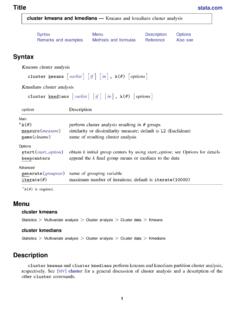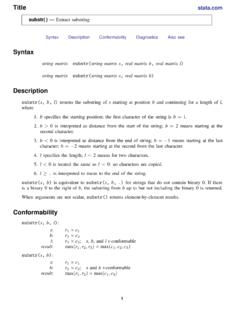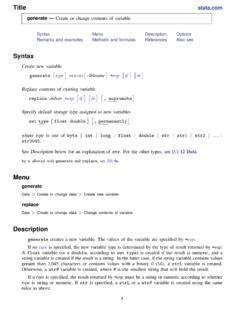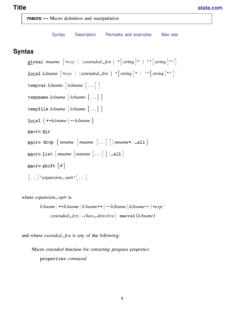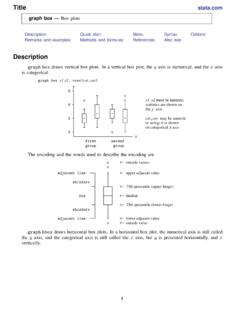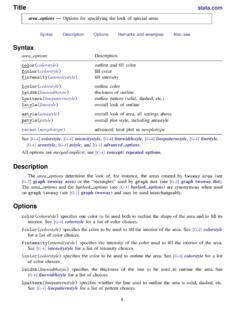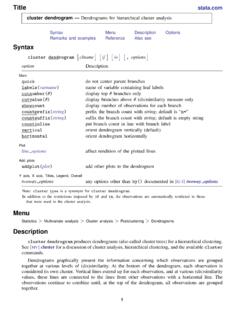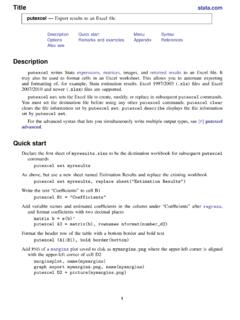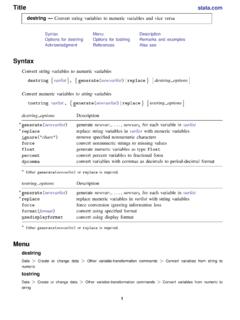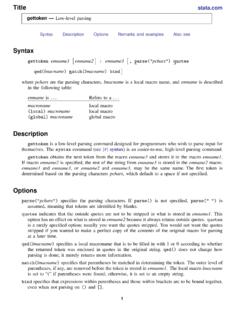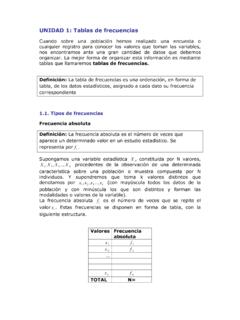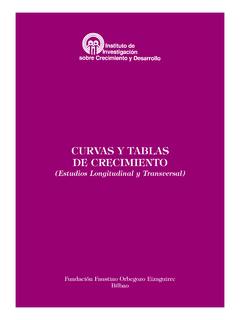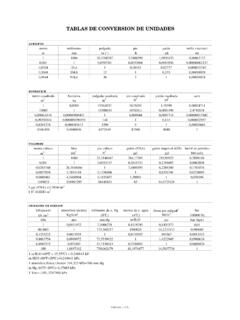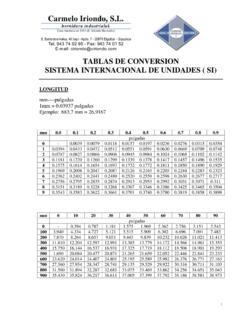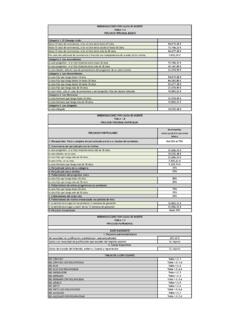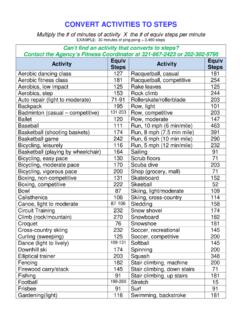Transcription of dfuller — Augmented Dickey–Fuller unit-root test - Stata
1 Augmented dickey fuller unit - root testSyntaxMenuDescriptionOptionsRemarks and examplesStored resultsMethods and formulasReferencesAlso seeSyntaxdfullervarname[if] [in] [,options]optionsDescriptionMainnoconsta ntsuppress constant term in regressiontrendinclude trend term in regressiondriftinclude drift term in regressionregressdisplay regression tablelags(#)include#lagged differencesYou musttssetyour data before usingdfuller; see [TS] contain time-series operators; see[U] Time-series >Time series> tests > Augmented dickey - fuller unit - root testDescriptiondfullerperforms the Augmented dickey fuller test that a variable follows a unit - root null hypothesis is that the variable contains a unit root , and the alternative is that the variablewas generated by a stationary process.
2 You may optionally exclude the constant, include a trend term,and include lagged values of the difference of the variable in the Main noconstantsuppresses the constant term (intercept) in the model and indicates that the processunder the null hypothesis is a random walk without be used with that a trend term be included in the associated regression and that the process underthe null hypothesis is a random walk, perhaps with drift. This option may not be used with that the process under the null hypothesis is a random walk with nonzero drift. Thisoption may not be used with that the associated regression table appear in the output.
3 By default, the regressiontable is not (#)specifies the number of lagged difference terms to include in the covariate dfuller Augmented dickey fuller unit - root testRemarks and and fuller (1979) developed a procedure for testing whether a variable has a unit root or,equivalently, that the variable follows a random walk. Hamilton (1994, 528 529) describes the fourdifferent cases to which the Augmented dickey fuller test can be applied. The null hypothesis isalways that the variable has a unit root . They differ in whether the null hypothesis includes a driftterm and whether the regression used to obtain the test statistic includes a constant term and timetrend.
4 Becketti (2013, chap. 9) provides additional examples showing how to conduct these true model is assumed to beyt= +yt 1+utwhereutis an independently and identically distributed zero-mean error term. In cases one and two,presumably =0, which is a random walk without drift. In cases three and four, we allow for adrift term by letting be dickey fuller test involves fitting the modelyt= + yt 1+ t+utby ordinary least squares (OLS), perhaps setting =0 or =0. However, such a regression is likelyto be plagued by serial correlation. To control for that, the Augmented dickey fuller test instead fitsa model of the form yt= + yt 1+ t+ 1 yt 1+ 2 yt 2+ + k yt k+ t(1)wherekis the number of lags specified in thelags()option.
5 Thenoconstantoption removes theconstant term from this regression, and thetrendoption includes the time trend t, which bydefault is not included. Testing =0 is equivalent to testing =1, or, equivalently, thatytfollowsa unit root the first case, the null hypothesis is thatytfollows a random walk without drift, and (1) is fitwithout the constant term and the time trend t. The second case has the same null hypothesis asthe first, except that we include in the regression. In both cases, the population value of is zerounder the null hypothesis. In the third case, we hypothesize thatytfollows a unit root with drift, sothat the population value of is nonzero; we do not include the time trend in the regression.
6 Finally,in the fourth case, the null hypothesis is thatytfollows a unit root with or without drift so that isunrestricted, and we include a time trend in the following table summarizes the four underRegressiondfullerCasenull hypothesisrestrictionsoption1 Random walk without drift = 0, = 0noconstant2 Random walk without drift = 0(default)3 Random walk with drift = 0drift4 Random walk with or(none)trendwithout driftExcept in the third case, thet-statistic used to testH0: = 0does not have a standard (1994, chap. 17) derives the limiting distributions, which are different for each of thethree other cases. The critical values reported bydfullerare interpolated based on the tables inFuller (1996).
7 MacKinnon (1994) shows how to approximate thep-values on the basis of a regressionsurface, anddfulleralso reports thatp-value. In the third case, where the regression includes aconstant term and under the null hypothesis the series has a nonzero drift parameter , thetstatistichas the usualtdistribution;dfullerreports the one-sided critical values andp-value for the test ofH0against the alternativeHa: <0, which is equivalent to < Augmented dickey fuller unit - root test 3 Deciding which case to use involves a combination of theory and visual inspection of the economic theory favors a particular null hypothesis, the appropriate case can be chosen based onthat.
8 If a graph of the data shows an upward trend over time, then case four may be preferred. If thedata do not show a trend but do have a nonzero mean, then case two would be a valid 1In this example, we examine the international airline passengers dataset from Box, Jenkins, andReinsel (2008, Series G). This dataset has 144 observations on the monthly number of internationalairline passengers from 1949 through 1960. Because the data show a clear upward trend, we use thetrendoption withdfullerto include a constant and time trend in the Augmented dickey use (TIMESLAB: Airline passengers). dfuller air, lags(3) trend regressAugmented dickey - fuller test for unit root Number of obs = 140 Interpolated dickey -FullerTest 1% Critical 5% Critical 10% CriticalStatistic Value Value ValueZ(t) approximate p-value for Z(t) = Std.
9 Err. t P>|t| [95% Conf. Interval] .0752195 .0799894 .399082 ..0876692 ..0879922 ..2098378 .9925118 we can overwhelmingly reject the null hypothesis of a unit root at all common significancelevels. From the regression output, the estimated of implies that = (1 ) = with fewer or more lags in the Augmented regression yield the same 2In this example, we use the German macroeconomic dataset to determine whether the log ofconsumption follows a unit root . We will again use thetrendoption, because consumption growsover dfuller Augmented dickey fuller unit - root test.
10 Use (Quarterly SA West German macro data, Bil DM, from Lutkepohl 1993 Table ). tsset qtrtime variable: qtr, 1960q1 to 1982q4delta: 1 quarter. dfuller ln_consump, lags(4) trendAugmented dickey - fuller test for unit root Number of obs = 87 Interpolated dickey -FullerTest 1% Critical 5% Critical 10% CriticalStatistic Value Value ValueZ(t) approximate p-value for Z(t) = we might expect from economic theory, here we cannot reject the null hypothesis that logconsumption exhibits a unit root . Again using different numbers of lag terms yield the same resultsdfullerstores the following inr().
